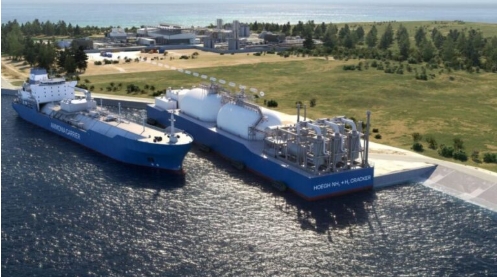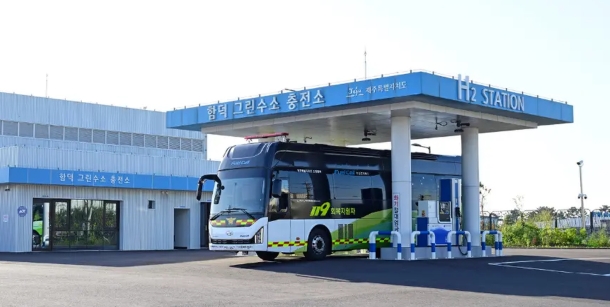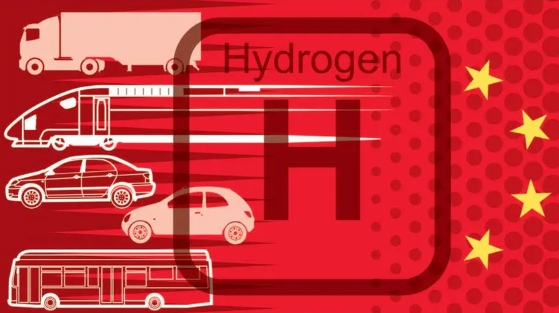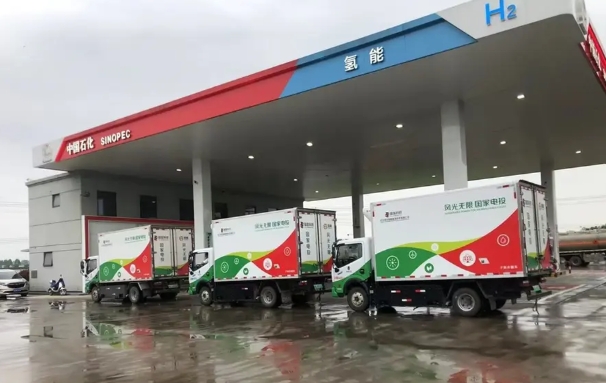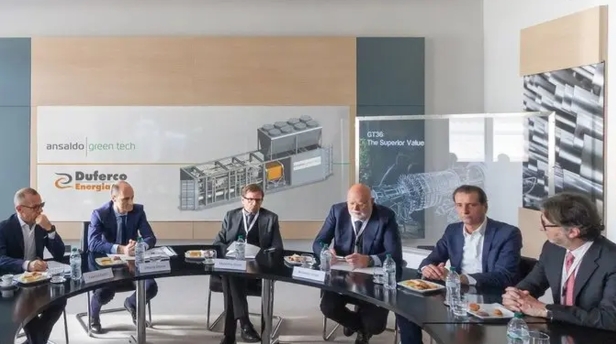
Five years of successful research for transferability to large cavern storage facilities
Rüdersdorf-- The energy service provider EWE has completed its HyCAVmobil research project at its gas storage site in Rüdersdorf near Berlin. As part of the hydrogen storage project, EWE and its partner the German Aerospace Center (DLR) were able to prove that it is possible to safely store hydrogen in an underground cavern storage facility. In addition, it has been shown that the purity of the hydrogen changes only minimally as a result of storage in a newly built cavern, such as the one in Rüdersdorf. This is especially important for use in the mobility sector.
Gaining knowledge for transferability to large-scale storage systems
The company is now transferring the knowledge gained from the construction and operation of the 500 cubic meter test cavern to caverns with a volume of 1,000 times. "Our goal is to establish large-scale caverns for hydrogen storage. With 37 salt caverns, EWE alone has more than 15 percent of all German cavern storage facilities that are suitable for storing hydrogen," explained EWE CEO Stefan Dohler at the final press conference in Rüdersdorf. This means that green hydrogen produced from renewable energies can be stored in large quantities and can be used as needed and will become an indispensable component in achieving the climate targets set. "With the proof of safe hydrogen storage, we have taken a big step towards climate protection and security of supply with renewable energies. With the help of hydrogen, the energy from the sun and wind can be stored in large quantities, especially for industrial use. Many more of us will follow this step along the entire value chain to keep our world worth living in," emphasizes Stefan Dohler.
Since the start of the HyCAVmobil research project in 2019, EWE has achieved various project milestones. There were also challenges, so that the project team had to adjust planned project steps again and again. "This is not unusual for a research project. After various technical adjustments, however, we were even more relieved when we had reached the first and most important milestone – before the actual construction of the single-family house-sized cavern. This was proof that the cavern borehole is leak-proof to a depth of 1,000 meters," reports Ralf Riekenberg from the EWE hydrogen team in Rüdersdorf. According to Riekenberg, there were unexpected and hydrogen-specific challenges with the cementation between the rock and the steel brutalization. However, EWE was able to locate and rectify the problem by means of several leak tests.
With the subsequent storage of hydrogen in the test cavern and the start of operation of the storage facility, EWE was subsequently able to gain experience for the injection and withdrawal of hydrogen at different pressures. DLR researchers have carried out extensive measurements of the gas composition. DLR has set up a new laboratory at the Oldenburg site for the HyCAVmobil project. It can be used to determine the quality and purity of hydrogen. Samples from the cavern in Rüdersdorf were also examined here. The quality of the extracted hydrogen is particularly relevant for use in fuel cells. Fuel cells can be used in vehicles, for example, and convert hydrogen into electricity for the electric motor. "Here we can answer the central research question of whether the cavern is suitable as a large-scale storage facility for hydrogen with 'yes' in this configuration. According to our investigations, the quality is still so high that a simple purification process is sufficient for further use," emphasizes Alexander Dyck, Head of the Urban and Building Technologies Department at the DLR Institute of Networked Energy Systems. "It was also a gain for us to be able to carry out measurements on a real cavern for the first time and thus provide important basic knowledge for the design of the future hydrogen infrastructure in Germany."
In a next step, EWE intends to transfer the findings from the Rüdersdorf project to a first large-scale project. Ralf Riekenberg: "At our cavern site in Huntorf in the Wesermarsch region, we are converting a natural gas cavern to store hydrogen. However, we have to look separately at the purity after hydrogen removal from this existing cavern. Because so far we have stored natural gas in this cavern, which we cannot completely get out of the storage facility." The Huntorf project is part of the large-scale connecting project "Clean Hydrogen Coastline". This brings together the production, storage, transport and use of green hydrogen – especially in industry – and thus implements the political demands. For the four-part large-scale project as part of the European IPCEI programme (Important Project of Common European Interest), EWE received funding notices from Federal Minister of Economics Habeck in the summer of this year. EWE is currently in the detailed planning phase and intends to store hydrogen in the next three to four years.
Lack of political framework jeopardizes implementation of H2 storage projects
For the subsequent use of further natural gas storage facilities or the construction of new underground hydrogen storage facilities, clarity about regulation and financing is needed quickly in view of the necessary lead times for commissioning. "No one can invest in hydrogen storage systems from scratch in a completely competitive manner in order to drive the market ramp-up," emphasizes EWE CEO Dohler, "just as a kind of start-up support is needed for the hydrogen core network, we will also need it in the storage sector. Because the fact is that only an interaction and simultaneous development of the hydrogen core network and hydrogen storage systems makes sense. This creates system stability and security of supply and enables the efficient integration of volatile renewable energies." The EWE CEO therefore calls for the political framework to be set quickly with the adoption of the hydrogen storage strategy and for core issues, such as the design of the market framework, to be clarified and state-backed financing mechanisms and concrete financing concepts for storage projects to be designed. "We are firmly convinced that hydrogen storage systems will play a decisive role in the future. Until the regulatory framework is clarified, we are therefore taking risks, doing preliminary work and developing concepts on how we can convert our current gas storage sites in Rüdersdorf, Huntorf, Jemgum and Nüttermoor for the storage of hydrogen and connect them to the hydrogen core network." Once the political framework is in place, EWE will then be able to make investment decisions quickly and start implementing its plans.
Rüdersdorf gas storage site has potential for integration into the hydrogen core network
With its proximity to the Berlin metropolitan region and the hydrogen pipelines, EWE's gas storage site in Rüdersdorf is geographically ideally located for the development of the hydrogen core network planned throughout Germany, the motorway for transport. For this reason, the company has already signed a letter of intent with ONTRAS Gastransport to integrate the site into the hydrogen core network. In addition, EWE has joined the "Flow – making hydrogen happen" cooperation project between the gas transmission system operators GASCADE, ONTRAS and terranets bw as a storage partner. This plans to build a transport infrastructure from northeast Germany to southwest Germany as part of the core network to link international hydrogen markets. "Our Rüdersdorf storage site can become a fundamental part of the hydrogen infrastructure in eastern Germany," says Stefan Dohler, "which is why we are currently evaluating the conversion and also the construction of further caverns at the Rüdersdorf site." In a next step, EWE will press ahead with project development for the Rüdersdorf site and make advance payments within the framework of its development budget. "We are ready and want to actively shape the future of energy. Once the regulatory framework is in place, we can be more specific. Until then, our small hydrogen test cavern will not be operated for the time being. However, we will carry out further tests on site from January. For example, we want to investigate the mixing behavior of hydrogen and natural gas as well as the water vapor content of hydrogen in more detail," reports Ralf Riekenberg.
14 million investments in the climate-friendly energy future
After five years of development work, the investment volume for the HyCAVmobil hydrogen storage project amounted to more than 14 million euros – almost eight million of which were EWE's own funds. EWE and its project partner German Aerospace Center (DLR) received the remaining sum of around 6.5 million euros as part of the National Innovation Programme for Hydrogen and Fuel Cell Technology as a grant from the Federal Ministry for Digital and Transport (BMDV). The funding guideline is coordinated by NOW GmbH and implemented by Project Management Jülich (PtJ).
HyCAVmobil: Project phases and milestones at a glance
Spring 2021: Installation and cementing of 160 steel pipes to a depth of 1,000 meters in an existing borehole in the salt dome below Rüdersdorf as the basis for the construction of the test cavern: The pipe-in-pipe system installed enables EWE to remove and use the inner pipe for later material tests.
Autumn 2022: Proof of leakage of the cavern borehole to the planned cavity down to a depth of 1,000 meters: For this purpose, EWE tested the cemented connection between the installed pipe-in-pipe system and the rock for leakage and provided proof that the borehole is leak-proof at the necessary pressures – as a prerequisite for the safe storage of the smallest molecule hydrogen.
Autumn 2022 to spring 2023: Brine removal and creation of the cavity in the salt dome under Rüdersdorf for the storage of hydrogen and the subsequent operational tests
Spring to autumn 2023: Construction of the above-ground facility for the operation of the hydrogen storage facility
Autumn 2023: First hydrogen storage
Winter 2023 to autumn 2024: Operational tests of the hydrogen cavern and hydrogen storage technology with different flow velocities, pressures and rest phases
HyCAVmobil: Insights
Hydrogen has a very high degree of purity after being extracted from the newly built cavern storage facility. This must be considered separately when converting natural gas caverns.
Due to the flow properties of hydrogen, tightness requirements for a hydrogen storage facility are higher than those for natural gas storage facilities, because hydrogen consists of smaller molecules than natural gas.
Hydrogen storage has been tested by the HyCAVmobil project, works and can be applied to large-scale caverns.
Simulated "mini cavern" provides insights into the material properties of infrastructures and how they can be maintained in the future. One example of this is pipelines. Both influences on the steel of these pipes and the microbial activity were investigated.
Special trace analysis can measure impurities in hydrogen and ensure its purity.
The scientific findings of the project are available to the public via DLR journal publications.
